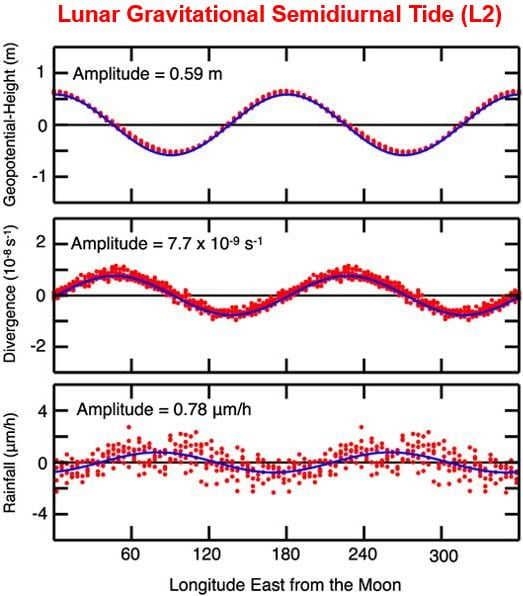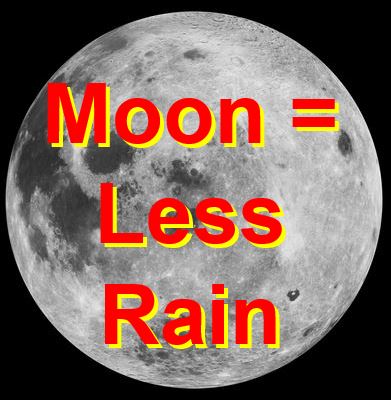The Moon makes it rain less because its gravitational pull creates bulges in the Earth’s atmosphere, making the air able to hold more moisture, say two researchers from the University of Washington in Seattle, USA.
Tsubasa Kohyama, a third-year doctoral student in atmospheric sciences, and John Wallace, a professor of atmospheric sciences, wrote about their study and findings in the academic journal Geophysical Research Letters (citation below).
They said that the lunar forces affect the amount of rainfall only very marginally – not enough for people to notice.
 Satellite data over the tropics shows a slight drop in rainfall when the moon is directly overhead or underfoot. Top panel – air pressure. Middle – rate of change in air pressure. Bottom – rainfall difference from the average. The change is 0.78 micrometers (less than 1/1000 of an inch) per hour. (Image: onlinelibrary.wiley.com)
Satellite data over the tropics shows a slight drop in rainfall when the moon is directly overhead or underfoot. Top panel – air pressure. Middle – rate of change in air pressure. Bottom – rainfall difference from the average. The change is 0.78 micrometers (less than 1/1000 of an inch) per hour. (Image: onlinelibrary.wiley.com)
Moon overhead causes air pressure to rise
Mr. Kohyama said:
“As far as I know, this is the first study to convincingly connect the tidal force of the moon with rainfall.”
While Mr. Kohyama was studying atmospheric waves, he noticed a slight fluctuation in the air pressure. He and Prof. Wallace spent two years studying the phenomenon and trying to find out why it occurs and what effect it might have on the weather.
Alterations in air pressure associated with the position of the Moon were first detected in 1847, and temperature changes in 1932, in ground-based observations.
In a previous paper, written by UW scientists, a global grid of data was used to confirm that air pressure on the surface is definitely affected by the Moon’s position.
Mr. Kohyama said “When the moon is overhead or underfoot, the air pressure is higher.”
The authors say theirs is the first study to show that the Moon’s gravitational pull also reduces the amount of rainfall.
 It’s not as black and white as this man is suggesting. When the moon is overhead, the chance of rain goes down by just 1%, so it might still rain.
It’s not as black and white as this man is suggesting. When the moon is overhead, the chance of rain goes down by just 1%, so it might still rain.
When the Moon is overhead, its gravity pulls on the Earth’s atmosphere, causing it to bulge, this makes the pressure or weight of the atmosphere on that side of the Earth rise.
Higher air pressure raises water-holding capacity
Greater air pressure raises the temperature of the air parcels below. Since warmer air is able to hold more moisture, the same air parcels are now farther from their moisture capacity, the authors explained.
Mr. Kohyama said:
“It’s like the container becomes larger at higher pressure. The relative humidity affects rain because lower humidity is less favorable for precipitation.”
Prof. Wallace and Mr. Kohyama used 15 years’ worth of data gathered by JAXA (Japan Aerospace Exploration Agency) and NASA’s Tropical Rainfall Measuring Missions satellite – 1998 to 2012 – to show that rainfall really is lighter when the moon is overhead.
Although the difference is small – about 1% – of the total rainfall variation, it is statistically significant, but not enough to affect other aspects of the weather or for people to notice any change.
 Prof John Wallace (left) and Tsubasa Kohyama.
Prof John Wallace (left) and Tsubasa Kohyama.
Mr. Kohyama added “No one should carry an umbrella just because the moon is rising.”
However, the authors believe this effect could be used to test climate models, to check their physics is accurate enough to reproduce how the gravitational pull of the moon eventually leads to less rain.
Prof. Wallace plans to carry on exploring Moon-influenced rain patterns to see whether certain types of rain, like torrential downpours, are more susceptible to the Moon’s position, and whether the frequency of rainstorms is in any way related.
The study was funded by the Iizuka Takeshi Scholarship Foundation and the Tanaka Ikueikai Scholarship Society in Japan, and the National Science Foundation in the USA.
Citation: “Rainfall variations induced by the lunar gravitational atmospheric tide and their implications for the relationship between tropical rainfall and humidity,” Tsubasa Kohyama and John M. Wallace. Geophysical Research Letters (Open Access). DOI: 10.1002/2015GL067342. January 2015.

